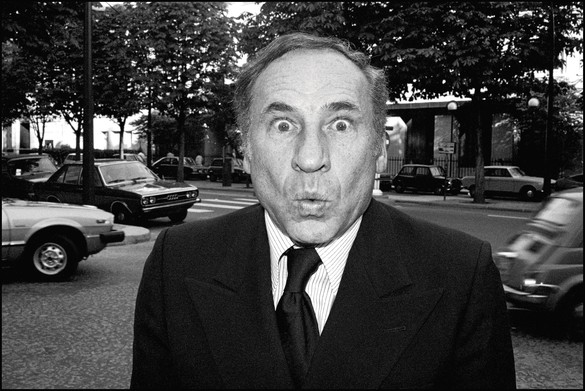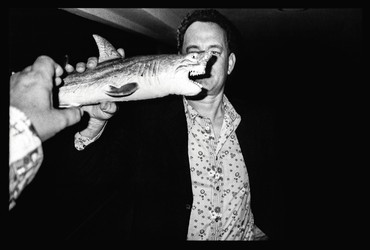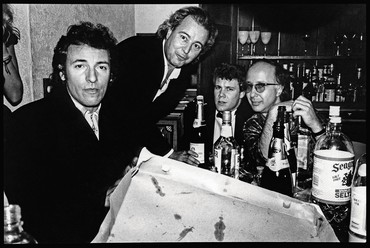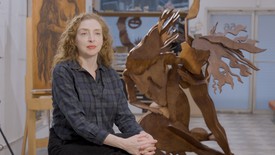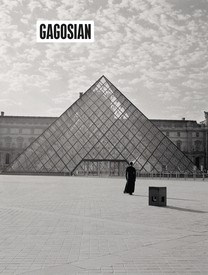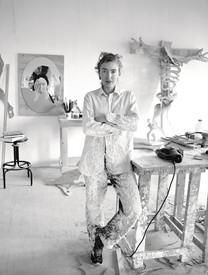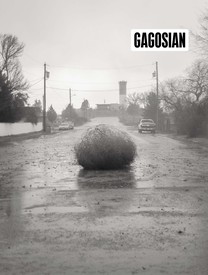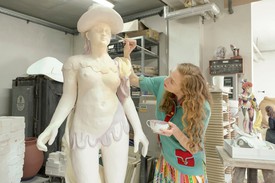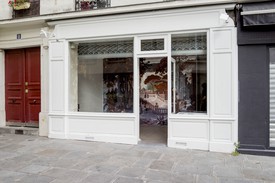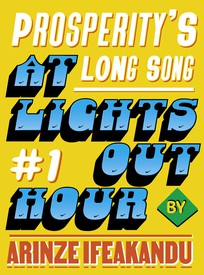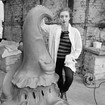
In richly detailed sculptures and multipart installations, Rachel Feinstein investigates and challenges the concept of luxury as expressed in eighteenth- and nineteenth-century Europe, in the context of contemporary parallels. By synthesizing visual and societal opposites such as romance and pornography, elegance and kitsch, and the marvelous and the banal, she explores issues of taste and desire. Photo: Markus Jans, Architectural Digest © Condé Nast

Jean Pigozzi picked up a Leica camera as an adolescent and began formulating a diaristic style that revolved around his observations of upper-class life. His “sophisticated snapshots,” significantly influenced by Robert Frank and Helmut Newton, are candid and intimate, capturing friends and others in scenes of social revelry or voluptuous leisure. Photo: Brett Ratner
Rachel FeinsteinJean, how are you? Receiving your book was a great gift during this time. Life has been so strange, given the pandemic and everything else, but at the same time, having a lot of time to just sit and think has been a blessing. It’s been intense. You’ve been in France the whole time?
Jean PigozziI was in Panama when everything started. I was there until the end of May and then I flew to my house in the South of France, and I have not moved one inch. I haven’t been on a plane for the last nine months.
RFWow. Have you ever stayed anywhere for—
JPNever. I’ve never stayed more than fifteen days in the same place for the last sixty years. But I can’t complain. I swim every day. My dogs can talk to me. I’m happy.
I’ve never been here in the winter, but it was so interesting to see the day become shorter and then the day become longer, and then there are beautiful flowers that come in the winter that I’ve never seen. I started taking black-and-white photographs of gardens. There’s a lady who runs a very important garden and she wants to do a book with me. But I said, My pictures are in black and white. She said, Exactly, I’m very interested because we never see pictures of gardens in black and white.
RFThat is so true.
JPSo I visited some incredible gardens with people who tell me all these names in Latin. I have no idea what they’re talking about, but it’s been very interesting.
RFDid you know there’s an app you can get on your phone that identifies flowers through the camera? It’s really fantastic, since I’ve never been able to figure out what’s what. And that’s the same thing with us, we were out in the North Fork of Long Island, where I’ve never spent more than a weekend. We have a little farmhouse that’s very simple and we usually just go there on weekends. We were there for four months.
But I want to go into your book—it’s incredible! I love the photographs so much because you literally capture every single person in a different light; you get them in a way that most people don’t see them, which is the whole idea of being part of the inner club, of this inner world that you’ve been part of your whole life. You know, coming from Miami, I’ve often had this feeling of otherness. Miami in the 1970s and ’80s was not the Miami that people know now, it was really off the charts in terms of weirdness. When I was young and in this off-the-radar place, the fantasy was that all these celebrities and fabulous people—Sting to Steve Jobs to David Geffen to Mike Nichols—everybody, all knew each other secretly and had this secret life outside of what the general population really knows and understands. And then in reality, it’s kind of true [laughter]. Everybody in that world, they’re all really good friends and you’re giving people this little peek into it. The worlds of cinematography, technology, fashion, art, music, even lawyers . . . they’re part of this incredible, sexy inner sanctum, and you give us a chance to see it.
And because the book is about men, because it singles them out, it made me think of how men, as a group, in our new world are in a different position than they had been. You’re capturing the last of a kind, in a way. You take it to a level where you say, This is my life and I don’t know if this is ever going to be a life that anyone could ever lead again. I think it’s touching.
So, I wanted to ask you, were you ever afraid that, being as open as you are, and how smart as an artist to show things the way they are, you would offend anybody in the book? Did you think, Maybe I shouldn’t present this photograph this way?
JPWell, I have some pictures I didn’t include, and I also had some people I couldn’t include. But I was careful—I don’t feel that I included any embarrassing pictures. You know, there are no people vomiting, people not with their wives, people naked . . . not that I have many of those. I think one of the reasons people let me take pictures of them is that they trust me. They trust that I won’t use bad pictures. You know, I’m not a paparazzo who hides behind a tree with a long lens. I’m always like two feet away from people.
RFWell, that’s because you’re part of the thing.
JPI’m part of the thing. Yeah, and the funny thing now, if I go to a party and I don’t take pictures, people say, Was my party no good? Why are you not taking pictures? They get upset, but the thing is, I very often use a very small camera so it’s not scary. I have a big hand, so people rarely even see the camera; I take one or two pictures and then I walk away. It’s not threatening, and I think the result, you can see, is that they’re not scary pictures.
RFWhen was the first time you did this? When was the very first moment where you said, I love doing this, I love taking pictures of people at parties? Do you remember the first moment?
JPOh, I don’t know. You know, I’m dyslexic. My handwriting is unreadable. I always wanted to document my life, but writing was out of the question, so I started taking pictures at about nine or ten. And when I was in college, that’s when parties became my main interest. I’ve always taken pictures of my friends and things around me. Actually, the first selfie I ever took was with Faye Dunaway in 1973 at Harvard.
RFI love the pictures you took of Henri Cartier-Bresson and people like Laurence Olivier. Now, you didn’t know them, right?
JPNo, but I admired them. You saw the picture of Francis Bacon on 57th Street?
RFYes. Incredible!
JPI’d never seen him before that moment—I said, This guy must be Bacon, and I took his picture. I really didn’t know, but turns out I was right. And then the funniest story was when I took a picture of Lucian Freud, which is in the book, at the River Café. In those days he didn’t want to have his picture taken, so he had his girlfriend come over to tell me that he hated it and wanted me to turn over the picture. So I told her, Okay, I’ll give him the negatives if he gives me a drawing [laughter]. That didn’t go over so well.
RFSee, that’s the thing, it’s so important to get these little stories. I love that each image comes with a little text you wrote. I just wanted more! I loved that your voice came through on every single one of them. To go back to the idea of having a book on just men, versus making it men and women or just women—what was your thinking? Are you going to do a book about women eventually?
JPI’ve started doing exactly that. The women book will be different. The story about the book of men is: My father died when I was twelve, okay? So I had a lot of mentors in my life, and a lot of the people in the book are my mentors. There are about ten in there that have been very, very important men in my life. Now that I’m becoming . . . I’m old, I’m sixty-nine—I now have some young people I talk to. The thing of mentoring I find incredibly interesting. People like Ahmet Ertegün—
RFI love that picture of him, with the Mercedes-Benz broken down and his hands up. That’s a fantastic image.
JPYou remember them all! So, Ahmet, I met him at the pool of the Beverly Hills Hotel when I was twenty-five. We became instant friends because we were wearing the same polo shirt. That’s it . . . we became friends and traveled together for many years. He gave me three rules in life: One, never go to the office before noon; you can work from home, but you don’t go to the office until noon. Two, business should be fun. And the third one, women like to have sex. These changed my life.
RF[Laughs] Those are very good points. Yes.
JPThis book, it took me forty years to take the photographs and some of them are very old. But you know, the hardest part was writing the little entries. It was a complete torture.
RFThat’s a beautiful point about being a mentor. Having this advice that you’ve accrued, and being able to pass that along, is priceless. The funny thing is, I have young people that I want to share advice with, but they’re absolutely not interested. They don’t want any advice whatsoever [laughs]. But really, you have every great person from every art form—I don’t think you forgot anybody.
JPWell, now I wake up at night because, Oh, I forgot that person. I’m going to have a few enemies.
RFNo! I don’t think so. It’s wonderful how you have the greats, but then you have your swimming coach. There are some personal touches throughout that are beautiful. And I love the picture of Larry [Gagosian] with the Charles Ray sculpture next to him [laughs]. It’s so good. I applaud you, Jean.
JPWell, thank you so much.
RFJohn [Currin] looked through it with me and he loved it, just like me. I’m curious to see what’s going to happen with the women book next.
JPThe women—well, let me ask a question. Let’s say I include a picture of you, and, as is often the case, let’s say you’re at a party with a few of your female friends. I don’t know their names. Would you feel offended if I only put “Rachel”? If I don’t put your family name? Would your friends?
RFI don’t think so, but I’m a lot more informal that way. The only thing I would say is, maybe people would get offended now that you have the man book and the men get the full name. They’d compare it and you have to be careful about that.
JPThat’s right. But you see, for the women’s book, I don’t want to give any details. I want people to imagine what the context or relationship might have been. I want it to be more mysterious.
RFYeah, I like that. But the thing is, the gossip makes it extremely interesting, because it goes back to what I was saying originally: that it’s this kind of little insight into this inner world that everybody wants to know. Actually, it’s not really even that tiny a glimpse; it’s extremely generous, really. That’s what’s so endearing and true and exciting. You’re doing it because you have this incredible eye and this wonderful heart and you’re joining them both by looking and also lovingly telling at the same time. How to follow through with the opposite sex . . . I mean, have you ever been a mentor to a woman or had a woman be your mentor, or is it very different?
JPI have had female mentors, yes, and now I have a few daughters of friends of mine who say, Oh, you’re friends with my dad, but there’s something I can’t really ask my dad, or, My dad doesn’t tell me about this, what do you think of it? Like business things, or they even tell me about their boyfriends and things like that that they don’t want to discuss with their dads. It’s so much fun, and it’s interesting and I hope I give them the right answers because I’m kind of guessing [laughter].
And then the other book I’m working on is about all the traveling I did.
RFThat’s fantastic. You have to talk about the stories on those trips, because that would be just incredible.
Artwork © Jean Pigozzi
Jean Pigozzi, The 213 Most Important Men in My Life (Bologna: Damiani, 2021)
